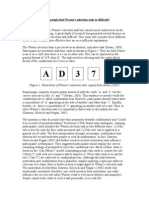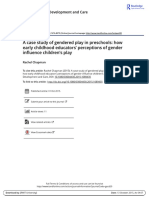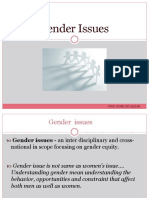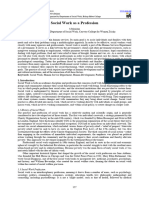Gender Identity
Gender Identity
Uploaded by
Miss_M90Copyright:
Available Formats
Gender Identity
Gender Identity
Uploaded by
Miss_M90Copyright
Available Formats
Share this document
Did you find this document useful?
Is this content inappropriate?
Copyright:
Available Formats
Gender Identity
Gender Identity
Uploaded by
Miss_M90Copyright:
Available Formats
Gender Identity There are many theories into the formation of gender identity.
Psychoanalytical theory emphasises the importance of identification of same-sex parent, social learning theory emphasises the explicit rewards and punishments for behaving in sex-appropriate ways as well as vicarious learning that observation and modelling can provide, and cognitive developmental theory emphasises the ways in which children socialise themselves once they have firmly labelled themselves as male or female (Maccoby & Jacklin, 1974). For the purpose of this essay, I will discuss three theories in regard to gender identity. The first is Kohlbergs cognitive developmental theory, second is the gender schema theory and lastly is the organisation-activation hormones theory. Evidence and research will be presented and evaluated for each theory. Cognitive Developmental Theory The basic principle of Kohlbergs CDT is that a child's understanding of gender develops with age. There are three stages involved. The first is gender identity which happens at about 2 years of age, and it is where the child recognises they are male or female and other people are as well. The next stage happens at about the age of 4 and is called gender stability. Here, the child now understands that their gender is fixed and will be male/female when they are older. The last stage is gender constancy, which happens between the age of 5 and 7 and is the stage at which the child understands that changes in appearance does not alter sex. For example, a girl wearing jeans is still female. Once children achieve this understanding about themselves, information about gender categories is believed to take on greater significance in how children respond to gender norms, develop relevant attitudes, and guide their behaviours. Cognitivedevelopmental theory also emphasizes that gender development involves an active construction of the meaning of gender categories, initiated internally by the child rather than externally by socialization agents. Finally, it argues that mastery or competence motivation is a driving force in gender development, as children seek to bring their perceptions and behaviours in line with their developing knowledge about gender categories. Evaluation and Evidence Kohlberg is not always clear about the extent of gender knowledge required to understand each stage. Contemporary cognitive-developmental theorists have agreed that basic gender identity has motivational significance but have also suggested that higher levels of gender understandingnamely, stability or consistencymay provide an additional or different kind of motivation for children to actively socialize themselves with regard to gender (Ruble, 1994). For example, basic gender identity may increase interest in and information seeking about gender, whereas more sophisticated levels of understanding may enhance childrens desire to ensure that they are behaving in accordance with gender norms. Given that sex differences occurs before the age that children gain a full understanding of gender constancy, the question is whether Kohlbergs theory contributes to further distinguishing gender differences. The main hypothesis that has been tested is that higher levels of gender constancy are associated with an increased responsiveness to gender related information and having a more rigid application of gender norms. Numerous studies support
the idea that gender constancy understanding influences gender-typed behaviours, but there are many mixed or null findings as well. There is current research to show significant relationships between gender constancy understanding and other aspects of gender development e.g. selective attention, same-sex modelling, same-sex activity, clothing and peer preferences, gender stereotype knowledge and affective indices of heightened responsiveness to gender. In some cases these relations hold for the highest stage of gender constancy, however the lower levels of gender stability or gender identity is more apparent in other cases. A final general point about relations with constancy, alluded to above, is that Kohlberg (1966) may have erred in emphasizing the final stage of gender constancygender consistencyas the most important level of understanding for motivating gender role adherence in children (Maccoby, 1990). When the literature on relations between level of gender constancy and responsiveness to gender-related information is reviewed, gender consistency does not emerge as the crucial component (Ruble & Martin, 1998). Instead, significant relations often involve lower levels of understanding, such as gender stability and even gender identity. Does this observation invalidate cognitivedevelopmental theory? As Maccoby (1990) notes, Kohlberg may have been right about the motivational importance of a firm gender identity for promoting gender differentiation, even if this identity emerges earlier than Kohlberg thoughtthat is, prior to full gender constancy. The crucial cognitive achievement in Kohlbergs view is childrens recognition of the categorical significance of gender, which in turn motivates them to comply with gender norms at a particular point in development. The cognitive approach to gender development gained even more momentum with the advent of the gender schema theory. The gender schema theory (Bem, 1981) is an informationprocessing approach where the distinction between male and female serves as a basic organising principle for every human culture. It argues that the developing child is learning content-specific information, the particular behaviours and attributes that are to be linked with sex. Schemas direct children in an active manner, in that children are motivated to seek information about gender as soon as they can identify themselves as boys or girls. More specifically, once they recognise their membership in a gender category, children seek details and scripts for same-sex activities and are more attentive to differences between boys and girls. From a cognitive perspective, childrens growing knowledge about what boys and girls like and how they differ is expected to influence and guide childrens own interests and behaviours. How might gender schema theory apply to gender identity? The child learns to apply this same gender schematic processing/selectivity to the self. Thus gender identity emerges as the child also learns to evaluate his or her adequacy as a person in terms of gender schema, to match his or her preferences, attitudes, behaviours and personal attributes against prototypes stored within it. This induces an internalised motivational factor that prompts the individual to regulate his or her behaviour so that it conforms to the cultures definitions of maleness and femaleness. And that sex-typed behaviour in turn further reinforces the gender-based differentiation of the self-concept through the individuals observation of his or her own behaviour (Bem, 1972).
It is important to note that gender schema is a theory of process and not content. Because sextyped individuals are seen as processing information in terms of and conforming to whatever definitions of masculinity and femininity the culture dictates. Evaluation and Evidence Bradbard and Endsley (1983) found a powerful influence of gender stereotypes on childrens preference to toys. Children played more with own-sex-labelled toys than with other-sex labelled toys, and both-sex toys were intermediate. Childrens memories also showed an influence of gender labels: Children recalled more names of own-sex labelled toys than othersex labelled toys and both-sex toys were intermediate (Bradbard & Endsley, 1983). Several other studies have demonstrated similar patterns of results on childrens behaviour and preferences (e.g. Martin et al.1995). Furthermore, when the influence of gender stereotype labels and sex of models have been directly compared, gender labels have been found to influence childrens behaviour more than models sex (Masters, Ford, Arend, Grotevant, & Clark, 1979). Gender stereotyping labels also have been demonstrated to influence childrens motivation, accuracy, and expectancies for success (Davies, 1986, 1989). The most commonly cited evidence concerning stereotype knowledgebehaviour links have been correlational studies. The evidence from these studies is mixed. Also, very few studies have tackled the most relevant issuewhether specific knowledge about which sex is more likely to do a particular behaviour (or who they think should do this more often) relates to the likelihood of children engaging in that behaviour. Thus, there is little direct evidence relevant to this issue. Gender stereotype knowledge is also considered to be only one of many factors (e.g., toy attractiveness, social desirability, personal skills, and familiarity) likely to affect childrens decisions about what they like and what behaviours they choose to engage in. Just because a girl learns that dolls are for girls and trucks are for boys does not mean that she will always choose a doll over a truck when given a choice. For instance, toy attractiveness influences childrens choices. Unfortunately, many tests of the relation between knowledge and preferences involve measures in which the attractiveness of items is not equated or taken into account. Organisation-Activation Theory on Hormones The long-held nurture versus nature debate has also been applied to gender identity. From a biological perspective, gender identity is easily recognised through the genitals. Research has even established that sex hormones (i.e. testosterone and oestrogen) are organised during the early prenatal stages of development, and is then later activated during puberty the onset of sexual maturation (Phoenix, Goy & Young, 1959). This has been labelled as the organisationactivation theory which explains sexual dimorphic behaviours. However there have been unique cases of individuals who are born with biological characteristics of both males and females. Some had been born with genitals ambiguously male-like and female-like. Others were born with one ovary and one testis or with gonads combined into ova-testes or they might have had sex chromosomes, not of the typical male
XY or typical female XX composition. Determining gender identity in such cases becomes a lot more complicated. John Money studied these unique individuals and proposed his own theory of psychosexual neutrality at birth (Money, 1951), 1951). He proposed that attitudes and corresponding gender display were relatively independent of organizational prenatal biological forces and set by the boy or girl assignment at birth which was then reinforced by the experiences of life (Diamond, 1965). He believed that the uniqueness of human nature relies more on the social factors to determine the organisational effects of sexual behaviour. Many believed and accepted Moneys theory in that humans gender identity, unlike other animals, was basically the product of rearing, life experiences and acculturation. Evidence to support Moneys psychosexual neutrality at birth theory was mainly provided by inter-sex individuals who successfully adapted themselves to an assigned gender role inconsistent with one or more morphological criteria of sex. So essentially, the theory was not supported by normative data. However this was soon addressed in 1975 where David Reimer, a male twin, had his penis accidentally burned during phimosis repair at the age of 8 months. So it was decided that he would be raised as a girl after having his penis removed and going through preliminary feminising surgery. Monitored yearly along with having regular meetings with a local psychiatrist, the sex re-assignment was reported successful. Money (1975) wrote that no one would ever conjecture that the girl was born a boy. Her behaviour paralleled that of an active girl and was distinct from the boyish ways of her twin brother. These findings infiltrated the media and received major attention from the public as well as the medical society. Beliefs about gender identity being nurtured seem to prevail as numerous psychology and sociology texts used the case of David Reimer to support the contention that sex roles, gender identity and sexual behaviours could be essentially learned. It also seriously challenged the theory of significant prenatal behavioural organisation. These findings also encouraged physicians to perform surgery on inter-sexed individuals, believing they could be successfully raised to an assigned gender without feeling abnormal. The practice became standard that the American Academy of Paediatrics reported research on children with ambiguous genitalia has shown that sexual identity is a function of social learning through differential responses of multiple individuals in the environment (Catlin & Crawford, 1994). Based on Moneys theory, physicians believed that individuals were psychosexually undifferentiated (neutral) at birth however the appearance of genitalia crucial and therefore surgery should be done to decrease gender ambiguity. Further support for this procedure was provided by positive reports from parents of children who had problems with their genitals, if they were counselled appropriately (Money et al, 1981). Suffice to say, the theory of organisation-activation effects had little impact on paediatricians and the theory of psychosexual neutrality was widely accepted. However, transsexuals individuals who were raised normally and had no problems with their genitals openly challenged both their gender rearing and denying their biological sex as their gender identity. Instead, transsexuals reported feeling like the opposite sex from as early as an age they could remember. One would think this would cast doubts in the relevance of nurture in gender identity however instead, transsexuals were believed to have a mental problem a gender identity disorder or gender identity dysphoria as so recorded in the DSM-IV-TR (2000).
However, biological evidence for the organisation-activation effect theory was developing and challenged the theory of sexual neutrality at birth. Research found that gonadal hormones appear to influence development of some human behaviour that shows sex differences. The evidence is strongest for childhood play behaviour and is relatively strong for sexual orientation and tendencies toward aggression (Collaer & Hines, 1995). Also, research demonstrating the testosterone generated organisation of sexual behaviour for animals began to accrue (Beach, 1976). Also, by 1980 it was revealed that things for David Reimer had not been going as predicted. Even without knowing that he had been sex re-assigned, he did not respond well to his upbringing as a female and the absence of his penis did not seem to deter his identification as a male or decreasing his masculine behaviours. The truth about his case was only publically revealed in 1997 where David admitted that he never truly felt like a girl and demonstrated from early on that he behaved more typically like a male. Further evidence against the theory of the psychosexual neutrality at birth came from Reiner who had reported on a male teenager who was reared as a girl from birth yet he still announced himself male at the age of 14. The impact was immediate. Physicians began to finally question their clinical practice regarding sex re-assignment and it seemed to overall suggest that being male or female was innate, immune to the interventions of doctors, therapists and parents (Angier, 1997). The theory of psychosexual neutrality was weakened whereas that of prenatal organisation and subsequent activation was given support. In a review paper by Cooke et al (1998), they summarised much of the accruing evidence on the influence of pre- and postnatal androgens in masculinising the male nervous system and behaviour in humans and animals. It stated that there were ample of evidence if sexual dimorphism in the human brain, as sex differences in behaviour would require, but there has not yet been any definite proof that steroids acting early in development directly masculine the human brain. This might explain why cases like David Reimer began to strongly fight against their sex re-assignment during the peak years of puberty (i.e. 14), presumably to do with the activation effects of sex hormones that occurs in puberty. Additionally, it seemed that the organisation-activation effects theory could also help explain transsexual development. It appears that that the extent of androgens exposure in the brain in utero, early postnatal period and at puberty has more of an effect determining male gender identity than sex of rearing and sociocultural influences when there is inadequate testosterone production or action where adequate androgens imprinting in the brain has NOT occurred then the sex of rearing becomes the predominant factor (Imperato-McGinley, 2002). Zucker (2004) did a review on gender identity development and related issues regarding children with gender dysphoria. In respect organisation-activation effects theory, he stated the transsexuals may feel the need to convert to the opposite sex due to less pronounced variations of the prenatal hormonal milieu that do not affect genital differentiation but plays a part in expressing dimorphic behaviour. In similar cases of David, Reiner found that active prenatal androgens effects appeared to dramatically increase the likelihood of recognition if male gender identity independent of sex-of-rearing. Increase levels of androgens in the brain may explain female-to-male transsexuals however in the case of male-to-female transsexuals the person would experience normal levels of androgens. The biological mechanism is unknown for how a female gender identity is developed although it must apparently override the effects of prenatal androgens (Gooren, 2006).
You might also like
- Sexual Market Value The Cynical Truth About What It Is How You Get It and How To Stop Yourself FromDocument83 pagesSexual Market Value The Cynical Truth About What It Is How You Get It and How To Stop Yourself Fromftyucbzjaoldtmkhvk91% (11)
- Wason's Selection TaskDocument5 pagesWason's Selection TaskMiss_M90100% (2)
- 'Rejections' & 'Years Ago'Document3 pages'Rejections' & 'Years Ago'Miss_M9067% (6)
- 120 Days of SodomDocument195 pages120 Days of Sodomtouchofclass562100% (1)
- Theme of Science in 'Dracula'Document2 pagesTheme of Science in 'Dracula'Miss_M90100% (2)
- Ryan Joelle Rubytrans Images Film and Media 2009Document376 pagesRyan Joelle Rubytrans Images Film and Media 2009chicano_delsuNo ratings yet
- Caliban's CharacterDocument1 pageCaliban's CharacterMiss_M90No ratings yet
- Cultural BiasDocument2 pagesCultural BiasMiss_M90100% (3)
- Marriage, Family, KinshipDocument50 pagesMarriage, Family, Kinshipcashielle arellanoNo ratings yet
- Jogappa Gender Identity and The Politics of Exclusion PDFDocument132 pagesJogappa Gender Identity and The Politics of Exclusion PDFGourangi KumarNo ratings yet
- Social Work Queer Theory and After A GenDocument28 pagesSocial Work Queer Theory and After A Gennaufrago18No ratings yet
- Socio-Economic and Educational Status of Muslim Women A Comparative OutlookDocument12 pagesSocio-Economic and Educational Status of Muslim Women A Comparative OutlookAlexander DeckerNo ratings yet
- Gendered Stereotypes and Norms A Systematic Review of InterventionsDocument15 pagesGendered Stereotypes and Norms A Systematic Review of InterventionsGisell De La Rosa GtzNo ratings yet
- Module11 GenderandsocietyDocument9 pagesModule11 GenderandsocietyRAMIL BAUTISTANo ratings yet
- GENDER IDENTITY by JULIAN AND MENDOZADocument29 pagesGENDER IDENTITY by JULIAN AND MENDOZACristy JulianNo ratings yet
- Field Work ReportDocument6 pagesField Work Reportnisarga lNo ratings yet
- Sexual Orientation and Gender Identity BillDocument3 pagesSexual Orientation and Gender Identity BillronnelNo ratings yet
- Code and Ethics of Social WorkDocument22 pagesCode and Ethics of Social WorkMridul Kumar Barman100% (1)
- Lesy 105Document32 pagesLesy 105muralidharanNo ratings yet
- Human Rights and Gender IdentityDocument52 pagesHuman Rights and Gender IdentityTRANScending BordersNo ratings yet
- PPT-1 - Concept of Health, Well-Being and DiseaseDocument24 pagesPPT-1 - Concept of Health, Well-Being and DiseaseSiddhant DebtaNo ratings yet
- AgingDocument6 pagesAgingVioto N KattyNo ratings yet
- Measuring Sexual Orientation and Gender IdentityDocument24 pagesMeasuring Sexual Orientation and Gender IdentityPetr ŠupaNo ratings yet
- Sexual & Gender Identity DisordersDocument42 pagesSexual & Gender Identity DisordersVikas SamotaNo ratings yet
- MSW ReportDocument30 pagesMSW ReportVivek Mathivanan100% (1)
- Gender Stereotyping CHRDocument25 pagesGender Stereotyping CHRNiranjana BijuNo ratings yet
- Gender IdentityDocument18 pagesGender IdentityNonito Vale100% (1)
- h.3 Gender Identity Edition 2018Document28 pagesh.3 Gender Identity Edition 2018Ptrc Lbr LpNo ratings yet
- Discuss The Use of Compliance TechniquesDocument3 pagesDiscuss The Use of Compliance Techniquesapi-249306416No ratings yet
- Basic Concepts in Gender StudiesDocument31 pagesBasic Concepts in Gender StudiesBere ChekwasNo ratings yet
- Gender InequalityDocument21 pagesGender InequalityJoshua B. JimenezNo ratings yet
- Women's RightsDocument8 pagesWomen's RightsXie YaoyueNo ratings yet
- Group Work in Different Settings PDFDocument61 pagesGroup Work in Different Settings PDFRashmi GowdaNo ratings yet
- A Case Study of Gendered Play in PreschoDocument15 pagesA Case Study of Gendered Play in Preschotmilic6No ratings yet
- Gender Issues: Prof. Ronel Rio AligamDocument52 pagesGender Issues: Prof. Ronel Rio AligamDnara PclbarNo ratings yet
- Gender Stereo TypingDocument32 pagesGender Stereo TypingCarol OcampoNo ratings yet
- Causes of Inequality in HealthDocument20 pagesCauses of Inequality in HealthLisa100% (1)
- Pro Social BehaviorDocument7 pagesPro Social BehaviorTARUSHI KAURNo ratings yet
- Gender Stereotypes - CultureDocument17 pagesGender Stereotypes - Cultureaswathy100% (2)
- Evidence Supporting The Biological Nature of Gender IdentityDocument6 pagesEvidence Supporting The Biological Nature of Gender IdentityMorgan Atwood100% (2)
- Lecture Notes 7 - SocializationDocument3 pagesLecture Notes 7 - Socializationpowerdgnflag100% (1)
- Chapter 3 3.4 Men and MasculinitiesDocument16 pagesChapter 3 3.4 Men and Masculinitiesfrancisdavemission1234No ratings yet
- Gender SensitivityDocument15 pagesGender SensitivityBlack AlphaNo ratings yet
- Karen HorneyDocument30 pagesKaren HorneyRhaine EstebanNo ratings yet
- Philadelphia LGBT AssessmentDocument68 pagesPhiladelphia LGBT AssessmentChris Bartlett100% (1)
- Chapter12 Feminist Therapy SummaryDocument7 pagesChapter12 Feminist Therapy SummaryJohnaliza LabanNo ratings yet
- Gender Roles and Society PDFDocument4 pagesGender Roles and Society PDFpanamoradoNo ratings yet
- Children and Sex Work (2016)Document2 pagesChildren and Sex Work (2016)Children's InstituteNo ratings yet
- Erik Erikson StagesDocument4 pagesErik Erikson StagesUmmi Norkhairiah Khir JohariNo ratings yet
- Program Evaluation of The Pine Lodge PreRelease Residential Therapeutic Community For Women Offenders in Washington StateDocument132 pagesProgram Evaluation of The Pine Lodge PreRelease Residential Therapeutic Community For Women Offenders in Washington Statelosangeles100% (1)
- Erikson - S Psychosocial TheoryDocument16 pagesErikson - S Psychosocial TheoryAnkit guptaNo ratings yet
- Gender DysphoriaDocument5 pagesGender DysphoriaRochelle Cuenca100% (1)
- Gender Based Violence PPTX 1 AutosavedDocument32 pagesGender Based Violence PPTX 1 AutosavedJesharelle ParciaNo ratings yet
- Sex Education in Primary SchoolsDocument6 pagesSex Education in Primary SchoolsScott RashNo ratings yet
- Rak College of Nursing, Lajpat Nagar, NEW DELHI 110024Document17 pagesRak College of Nursing, Lajpat Nagar, NEW DELHI 110024Pankaj S R MehrotraNo ratings yet
- Social Dimension - Sex and Education (Chapter 8)Document10 pagesSocial Dimension - Sex and Education (Chapter 8)Francis A. DiazNo ratings yet
- Social Work As A ProfessionDocument4 pagesSocial Work As A ProfessionIssa KhalidNo ratings yet
- Chapter 1 The Ethics of Social Work ResearchDocument6 pagesChapter 1 The Ethics of Social Work ResearchJolina BenderoNo ratings yet
- Lecture 9 Interpersonal Attraction and Close RelationshipsDocument6 pagesLecture 9 Interpersonal Attraction and Close RelationshipsCeline SinghNo ratings yet
- Crisis TheoryDocument26 pagesCrisis TheoryAndraNo ratings yet
- 2'23 Historical Background of CaseworkDocument24 pages2'23 Historical Background of CaseworkLowe CrisostomoNo ratings yet
- Can We Talk - Community ReportDocument111 pagesCan We Talk - Community Reportarcane25No ratings yet
- Sexuality in IslamDocument100 pagesSexuality in IslamRadulescu MarianNo ratings yet
- The Group Begins ReportDocument70 pagesThe Group Begins ReportJeremiah Magcalas100% (2)
- Women EmpowermentDocument20 pagesWomen EmpowermentParul RishiNo ratings yet
- Developmental StudiesDocument14 pagesDevelopmental StudiesJaneNo ratings yet
- Martin 1990Document14 pagesMartin 1990hsncsk98No ratings yet
- Cyber Bullying: Writing To ArgueDocument3 pagesCyber Bullying: Writing To ArgueMiss_M90No ratings yet
- AnxietyDocument5 pagesAnxietyMiss_M90100% (1)
- Moral ReasoningDocument5 pagesMoral ReasoningMiss_M90100% (1)
- Imagery of Music - Quotes and AnalysisDocument2 pagesImagery of Music - Quotes and AnalysisMiss_M90No ratings yet
- Dracula - Chapter 21Document1 pageDracula - Chapter 21Miss_M90No ratings yet
- Dracula - Chapter 17Document2 pagesDracula - Chapter 17Miss_M90No ratings yet
- Quote For Each ACTDocument1 pageQuote For Each ACTMiss_M90No ratings yet
- Notes On Van Helsing in 'Dracula'Document2 pagesNotes On Van Helsing in 'Dracula'Miss_M90No ratings yet
- Ariel - Real or Not?Document2 pagesAriel - Real or Not?Miss_M90No ratings yet
- Theme of Religion in 'Dracula'Document2 pagesTheme of Religion in 'Dracula'Miss_M90100% (5)
- Attitudes Towards ProsperoDocument2 pagesAttitudes Towards ProsperoMiss_M90No ratings yet
- Importance of Magic and Transformation in 'The Tempest'Document3 pagesImportance of Magic and Transformation in 'The Tempest'Miss_M90100% (3)
- Alonso and CourtiersDocument1 pageAlonso and CourtiersMiss_M90No ratings yet
- To Kill A Mockingbrid CourseworkDocument5 pagesTo Kill A Mockingbrid CourseworkMiss_M90No ratings yet
- The Tempest - Epilogue CriticismsDocument2 pagesThe Tempest - Epilogue CriticismsMiss_M9050% (4)
- Milgram EssayDocument9 pagesMilgram EssayMiss_M90No ratings yet
- The Macabre' GCSE Pre-1914 Poetry CourseworkDocument6 pagesThe Macabre' GCSE Pre-1914 Poetry CourseworkMiss_M90No ratings yet
- Great Expectations CourseworkDocument7 pagesGreat Expectations CourseworkMiss_M90No ratings yet
- Gender Bias in PsychologyDocument3 pagesGender Bias in PsychologyMiss_M90100% (3)
- Biology CourseworkDocument13 pagesBiology CourseworkMiss_M90100% (1)
- Chem CourseworkDocument6 pagesChem CourseworkMiss_M900% (1)
- Development of AttachmentsDocument2 pagesDevelopment of AttachmentsMiss_M90100% (1)
- The Playboy Rabbit Is Soft Furry and Cute Is ThisDocument155 pagesThe Playboy Rabbit Is Soft Furry and Cute Is Thisjula.szokalNo ratings yet
- MemorandumDocument5 pagesMemorandumJustine Ria AlmojuelaNo ratings yet
- The Institution of Kotha - A Case Study of Tawaif-Centered Films.Document4 pagesThe Institution of Kotha - A Case Study of Tawaif-Centered Films.Eesha Sen ChoudhuryNo ratings yet
- MODULE 1 (Lesson 2-3) in Gender and Society: Fiona Yvannie T. Murillo BSSW As 3-1Document6 pagesMODULE 1 (Lesson 2-3) in Gender and Society: Fiona Yvannie T. Murillo BSSW As 3-1Jenecile Parambita100% (2)
- National Statistics Domestic Violence NcadvDocument2 pagesNational Statistics Domestic Violence Ncadvapi-353949122100% (1)
- Changelog (Spoilers!)Document11 pagesChangelog (Spoilers!)Al SidNo ratings yet
- Tiger Wood MK UltraDocument7 pagesTiger Wood MK UltraRalph Torello100% (2)
- Gender Equality Still A Dream in India PDFDocument10 pagesGender Equality Still A Dream in India PDFJaskirat SinghNo ratings yet
- DivorceDocument24 pagesDivorceJelline TallaNo ratings yet
- Report of Cases of Abuse, Violence, Exploitation, Discrimination, Bullying or Peer Abuse and Other Related OffensesDocument6 pagesReport of Cases of Abuse, Violence, Exploitation, Discrimination, Bullying or Peer Abuse and Other Related OffensesJericha Era LabraNo ratings yet
- Understanding The Reptilian MindDocument24 pagesUnderstanding The Reptilian MindManuel Fernando NunezNo ratings yet
- Grounded - R.K LilleyDocument270 pagesGrounded - R.K LilleyAlexandra Drew95% (22)
- What It Means When She Says She Has A BoyfriendDocument17 pagesWhat It Means When She Says She Has A Boyfriendaran singh100% (1)
- People Vs Sanchez, 250 Scra 14Document12 pagesPeople Vs Sanchez, 250 Scra 14Add AllNo ratings yet
- LiteraryanalysisDocument2 pagesLiteraryanalysissaavedraotoyNo ratings yet
- Checklist For Sexual Harassment InvestigationsDocument2 pagesChecklist For Sexual Harassment Investigationspa3ckblancoNo ratings yet
- Sectoral AnalysisDocument416 pagesSectoral AnalysisNICOLE EDRALINNo ratings yet
- TocDocument8 pagesTocJamNo ratings yet
- Lawyersclubindia Article - Analysis of Section 354 - 355 of IPCDocument9 pagesLawyersclubindia Article - Analysis of Section 354 - 355 of IPCMahesh KalgeNo ratings yet
- TSSM Unit Two Exam 2016Document22 pagesTSSM Unit Two Exam 2016nisulNo ratings yet
- Tesis CarmillaDocument94 pagesTesis Carmillalilith.rei8374No ratings yet
- The Clause - Oct. 28Document12 pagesThe Clause - Oct. 28The ClauseNo ratings yet
- Delightful AsphyxiaDocument324 pagesDelightful Asphyxiaanisasyira06100% (1)
- Referencias Sexo - GeneroDocument3 pagesReferencias Sexo - GeneroCarmen LópezNo ratings yet
- Chi Ming Tsoi v. CA and Gina Lao-Tsoi (Case Digest)Document2 pagesChi Ming Tsoi v. CA and Gina Lao-Tsoi (Case Digest)Yuri SisonNo ratings yet
- Bailey Base and Friends - Google SearchDocument1 pageBailey Base and Friends - Google Searchyasheu808No ratings yet
- Characteristics of LifeDocument30 pagesCharacteristics of LifeLexis MakabaliNo ratings yet
- Undertaking Given by The Candidate: Admitted To Various Degree Programmes (2019 - 2020 Batch)Document1 pageUndertaking Given by The Candidate: Admitted To Various Degree Programmes (2019 - 2020 Batch)nagalaxmi manchalaNo ratings yet




















































































































